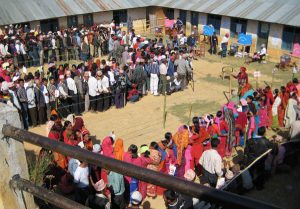Upcoming elections are last leg of institutionalizing federal democratic republic
November 21, 2017
By Janne Sunne
The federal parliamentary and provincial elections scheduled for November 26 and December 7 mark an end to the political transition that started with the Maoists joining the peace process ten years ago.
Nepal promulgated its new constitution two years ago enshrining the achievements of the 2006 people’s movement, mainly federalism, republicanism and secularism. The process of drafting the national charter by the Constituent Assembly also saw a bloodless end to the 240-year-old monarchy credited with laying the foundations of the modern Nepal but also blamed for its underdevelopment. There was not much public protest when the parliament passed a resolution motion to dethrone the monarch since King Gyanendra Shah had been hugely unpopular for his autocratic rule in the backdrop of erosion of public faith in the royal institution following the palace massacre of 2001 that killed popular king Birendra and his family. Nor was there widespread opposition when the country was declared a secular state since most people opposed to the king’s autocratic rule believed that the monarch derived some of his power from the place for kings in the Hindu belief system where he is believed to be a reincarnation of Lord Bishnu.
In a diverse and difficult geography like Nepal’s, the centralised state is held responsible for the regime’s disconnect with backward communities and the failure of development and good governance to trickle down to the grassroots. The Panchayat polity initiated by king Mahendra and carried forward by his son king Birendra, which lasted 30 years, had tried to decentralise rule by dividing the country into 14 administrative zones and five development regions but the arm of bureaucracy was so corrupt and irresponsible that there was no accountability for bad decisions, indecisions or inaction. It was the utter failure of the Panchayat to deliver on its stated promises that made the first people’s movement successful in 1990.
Thus began the second era of multiparty democracy which lasted for 16 years. A decade of this was beset by the Maoist insurgency while the unstable governments formed by the Nepali Congress and other parties shamelessly promoted corruption, nepotism and paralysis of public service delivery, leading to their own downfall. It was only after the state security forces’ failure to “finish off the Maoists” in combat that pushed the government, political parties and the palace to seek a political solution to the Maoist problem. Furthermore, when king Gyanendra assumed absolute power and cracked down on political dissent that party leaders opened up their channels with the Maoists and initiated the negotiation process.
A massive people’s movement, backed by the Maoists’ power, culminated in the restoration of the dissolved parliament by the king in 2006. An interim parliament, interim government and interim constitution preceded two Constituent Assemblies. The first CA was used by the Maoists and Madhesi groups and the old parties as the ring for political wrestling, with the former rebels flexing their muscle nurtured by the earlier military stalemate and their resounding electoral victory. They put an end to the politics of consensus necessitated by the parties’ unity against the monarchy. This stoking of rivalries led to the demise of the first Assembly without delivering a constitution even after a number of extensions of its tenure.
The promulgation of the constitution in 2015 was followed by India imposing a five-month long border blockade on Nepal, with the Madhes-based parties dissatisfied with a number of provisions of the new charter supporting New Delhi’s move to bring Nepal’s leadership to its knees for “not heeding India’s concerns in Nepal’s new dispensation”.
India’s highhandedness caused unprecedented suffering among the Nepalis, caused by acute shortages of fuel and foodstuff. The regional parties had made a second amendment to the constitution their precondition to participating in the three layers of elections that are necessary to implement the prescribed federal system. The local level elections, which have elected grassroots governments for municipalities and village councils to exercise autonomy and enormous political power, were held by two governments in three phases. When Maoist leader Pushpa Kamal Dahal took over KP Sharma Oli of the CPN-UML as the prime minister last year, conducting elections was viewed as a great challenge. The protesting parties were refusing to go to the polls. But the constitutional requirement of holding all the elections by the end of this year prodded all the forces to prepare for the ultimate democratic show.
PM Dahal made way for Sher Bahadur Deuba of the Nepali Congress in a power-sharing arrangement between the two parties. PM Deuba, who does not have a good democratic track record for having dissolved the parliament and submitted the powers of the elected institutions to the monarch in the past, is overseeing the elections.
A former Maoist splinter group is widely perceived to be attacking candidates and their campaign teams with improvised explosive devices, creating terror across the country. This level of insecurity and threat for the election was unforeseen by the security bodies and intelligence bodies. The Maoist party broke its alliance with the Congress to side with the communist UML with an ultimate goal of party merger.
The rivalry between the leftist and the Congress-led “democratic” blocs is turning ugly, though it may not have resulted in physical violence yet. The NC fears that the leftist alliance aims to steer the country away from the established democratic order while the Marxist-Leninists claim to be making efforts to end the chronically unstable practice of changing governments almost every year.
The first round of polling is less than a week away. With the local governments having been elected, the provincial elections will get representatives to form state legislatures and governments while the House of Representatives polls will lead to federal parliament and government.
As the parties jostle for political and social space, it’s the people who are the ultimate arbiters.

People queuing up at the poling stations to cast their votes (file photo).









